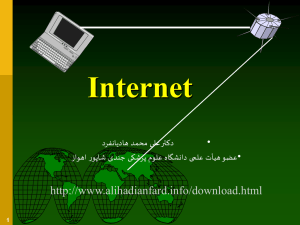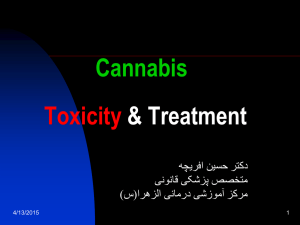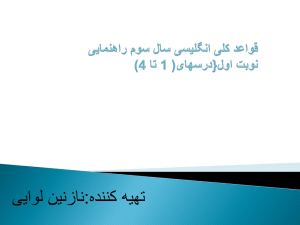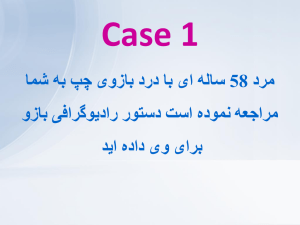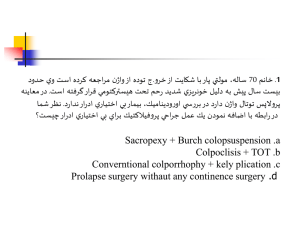principles of mktg
advertisement
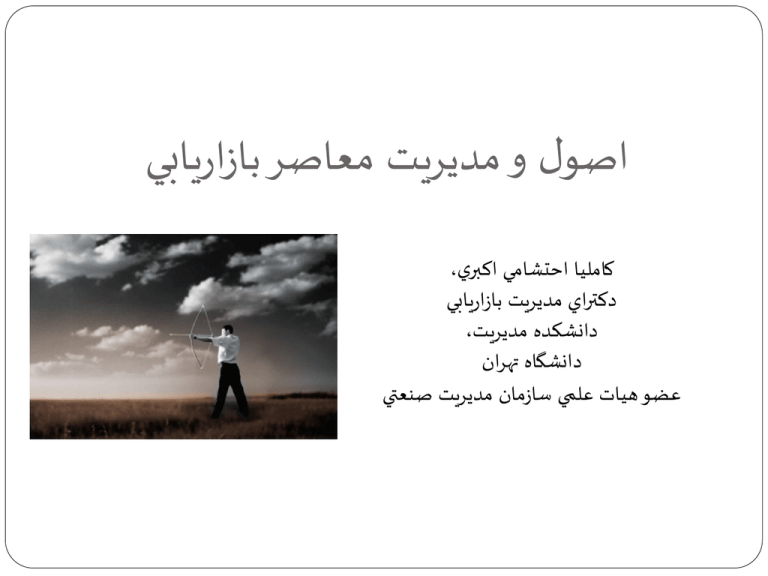
اصول و مديريت معاصر بازاريابي كامليا احتشامي اكبري، دکتراي مديريت بازاريابي دانشکده مديريت، دانشگاه تهران عضو هيات علمي سازمان مديريت صنعتي 1 مباني مديريت بازاريابي هدف: آشنايي با اصول بازاريابي در ابعاد تئوريك و عملي به نحوي كه شركت كنندگان قادر به تشخيص مسئله ،ارائه تعريف از مسئله و راه حل يابي براي مسئلهء بازاريابي سازمان خويش شوند. آشنايي با حوزه هاي مختلف عمليات بازاريابي آشنايي با اصول و هدف طرح بازاريابي 2 مهارت هاي اكتسابي در پايان درس تسلط تئوريك بر مفهوم و مكاتب بازاريابي تشخيص استراتژي هاي بازاريابي بر حسب نيازهاي سازمان توان اوليه درتدوين برنامه بازاريابي آشنايي با مفاهيم پايه مکتب مديريتي در بازاريابي 3 چند پيش فرض بازاريابي با مفهوم ”بازارياب“ و فروش تفاوت دارد. بازاريابي در اين درس به مفهوم مديريت بازار است. بازاريابي در شرايط غير رقابتي معنا ندارد .رقابت اصل زيربنايي بازاريابي است .صنايعي كه در داخل كشور مشمول رقابت نمي شوند (مثل صنعت خودروسازي و نه تامين قطعات خودرو و )....مشمول مفروضات بازاريابي نيستند. 4 روش ارزيابي كارگروهي آزمون (پروژه) مشاركت در کالس و در گروه خبري حضور و غياب شهروندي در كالس 5 عضويت در شبكه اجتماعي زينگ آدرس هاي پست الكترونيك خود را در همين كالس لطف كنيد .تا دعوتنامه خدمتتان ارسال شود. منابع مديريت بازاريابي (آقايان روستا ،ابراهيمي ،ونوس) تحول نظريه بازاريابي (ياگديش شث) اصول و مديريت بازاريابي (كاتلر ،ترجمه بهمن فروزنده) مقاالت ... 6 بازاريابي يعني جنگ 7 بازاريابي يعني جنگ هدف؟ ميدان جنگ؟ جنگ بر سر چي؟ آيا نيازي به استراتژي هست؟ سربازان چه كساني هستند؟ متحدين چه كساني هستند؟ 8 عواملي که بازارها را متحول ساخته اند (چالش ها و انگيزه ها): توليد در مقياس جهاني افزايش شکاف درآمدي محيط زيست و مسئوليت های اجتماعی تقسيم کار جهاني بلوک هاي تجاري و سازمان تجارت جهاني نقش فزاينده زنان در عرصهء توليد وکار .... و تکنولوژي و ارتباطات 9 تعريف بازاريابي در مکتب ”مديريتي“ بازاريابي يک فرايند اجتماعي و مديريتي است که افراد و گروه ها بوسيلهء آن نيازها و خواسته هاي خود را از طريق توليد ،عرضه و مبادلهء کاالهاي مفيد و با ارزش با ديگران تامين مي کنند. 10 نياز .عدم دسترسي به يک رضامندي اساسي است نياز يك فقدان است Maslow’s pyramid Can marketers create needs? “Marketers do not create needs: Needs preexist marketers. Marketers, along with Social factors, influence wants. Marketers might promote the idea that a Mercedes Would satisfy a person’s need for social status. They do not, however, create the need for social status.” Kotler, p. 11. 11 Maslow’s Hierarchy of Needs 5 Herzberg McClelland Selfactualization (self-development and realization) 4 Esteem needs (self-esteem, recognition) 3 2 12 1 Social needs (sense of belonging, love) Safety needs (security, protection) Physiological needs (food, water, shelter) خواسته ها . ميل و عالقه خاصي هستند که برطرف کنندهء نياز است، خواسته ها ؟؟؟؟ Adapt Maslow’s pyramid of needs to “wants.” What type of wants can you identify on each level? Can you increase wants as you go up the ladder? 13 Other Theories Herzberg: Satisfiers vs. Dissatisfiers McClelland: Affiliation, Achievement, Power 14 تقاضا خواستن برخي تقاضا ،همان ِ محصوالت خاص است که با توانايي خريد همراه شده باشد. يعني: خواسته +قدرت خريد = تقاضا 15 Potential Product Augmented Product Expected Product Basic Product Core Need 16 رضايتمندي و وفاداري بين وفاداری و رضايتمندی تفاوت اساسی وجود دارد .رضايتمندی مربوط به برآورده شدن نيازها است ،تفکر ذهنی منطقی و تحليل ارزش. وفاداری مربوط به رابطه عاطفی بين مشتريان شما و شرکت شما است. رضايتمندی آنچه که افراد بيان می کنند است ،وفاداری آنچه که انجام می دهند (.)Doren, 2006, p:1,2 وفاداری مشتری عموما در زمينه رفتارهای خريد مشتری تعريف شده است .در بعضی صنايع (مانند خرده فروشی ،خدمات) ،يک مشتری وفادار از طريق جزئيات خريدش تعريف شده است :فراوانی و ارزش پولی (.)Ou & Sia, 2003, p:1735 رضايتمندی صرف نمی تواند عاملی برای حفظ و نگهداری مشتری و در نتيجه سودآوری تلقی شود، تحقيقات بسياری نشان داده اند كه رضايتمندی كليد نهايی موفقيت و سودآوری نيست .در حقيقت مفاهيم بازاريابی هم كه تا ديروز براين مهم تاكيد می ورزيد ،ديگر آن را به رسميت نمی شناسد بلكه امروزه تنها مشتری مشعوف و شادمان و مشتری كه احساس تعلق خاطر و تعلق قلبی پيدا كرده برای سازمانها ،سرمايه هايی به شمار می روند كه سودآوری و عمر طوالنی دارند. Pantouvakisمدل رضایتمندی این مدل به عواملی نظير ملموسات ،تضمين ،پاسخگویی به مشتری ،اطمينان و همدلی اشاره نموده و بيان می دارد که هر یک از عوامل ذکر شده ارتباط متقابل با یکدیگر و با رضایتمندی مشتری دارند. ملموسات تضمين رضايتمندی پاسخگويی اطمينان همدلی شکل :4مدل رضایتمندی پانتوواکیس ()Pantouvakis, 2010, 373 ابزارهاي بازارياب محصول/خدمت كيفيتايده محصولتحقيق و توسعهعمر محصولنام محصولتوليدبسته بندي...- قيمت ترويج توزيع تقاضاسهم بازارقيمت تمام شدهادراكيفصليمناقصه ايحداكثر سود...- تبليغاتفروش حضوريترويجروابط عموميبازاريابي مستقيم...- درب كارخانهواسطهخرده فروشياينترنتي...- 21 انواع تقاضا و واكنش هاي بازارياب تقاضاي منفي :هنگامي که مصرف کنندگان به کااليي بي ميلي نشان مي دهند. تقاضاي صفر :هنگامي که مصرف کنندگان نسبت به وجود کاال آگاهي ندارند. تقاضاي پنهان :نيازي که توسط کاالهاي موجود تامين نمي شود. تقاضاي رو به پايين :از رونق افتادن محصوالت تقاضاي بي قاعده :تقاضاي فصلي و يا بي قاعده 22 Conceptualization of Strategy China’s most enduring game is Wei Qi (pronounced way chee).Wei qi translates as game of surrounding pieces, it implies a concept of strategic encirclement. The players take turns placing stones (180 each) at any point on the board, building up positions of strength, while working to encircle and capture the opponent’s stones. Multiple contests take place simultaneously in different regions of the board. The balance of forces shifts incrementally with each move, as the players implement strategic plans and react to each other’s initiatives. 23 At the end of a well-played game, the board is filled by partially interlocking areas of strength. The margin of advantage is often slim and to the untrained eye, the identity of the winner is not always immediately obvious. Chess on the other hand is about total victory. The purpose of the game is checkmate, to put the opposing king into a position where he cannot move without being destroyed. The vast majority of games end in total victory achieved by attrition or, more rarely a dramatic, skillful maneuver. The only other possible outcome is a draw; meaning the abandonment of the hope for victory by both parties. 24 25 If chess is about the decisive battle, wei qi is about the protracted campaign. The chess player aims for total victory. The wei qi players seeks relative advantage. In chess the player always has the capability of the adversary in front of him; all the pieces are always fully deployed. The wei qi player needs to assess not only the pieces on the board but the reinforcements the adversary is in a position to deploy. 26 In chess the game usually begins as a struggle for the center 27 of the board. Wei qi teaches the art of strategic encirclement. Where the skillful chess player aims to eliminate his opponent’s pieces in a series of head-on clashes, a talented wei qi player moves into “empty” spaces on the board, gradually mitigating the strategic potential of his opponent’s pieces. Chess produces single-mindedness. Wei chi produces strategic flexibility. Sun Tzu’s Art of War Western strategists test their maxims by victories in battles; Sun Tzu tests by victories where battles have become unnecessary. For Sun Tzu, far better than challenging the enemy on the field of battle is undermining an enemy’s morale or maneuvering him into an unfavorable position from which escape is impossible. Ultimate Excellence lies Not in winning every battle But in defeating the enemy without ever fighting’ The highest form of warfare is to attack the enemy’s strategy 28 To Sun Tzu, the strategist is akin to water flowing downhill, automatically finding the swiftest and easiest course. A successful commander waits before charging into battle. He shies away from an enemy’s strength; he spends his time observing and cultivating changes in the strategic landscape. He studies the enemy’s preparations and his morale, husbands resources and defines them carefully, and plays on his opponent’s psychological weaknesses – until at last he perceives the opportune moment to strike he enemy at his weakest point. 29 He then deploys his resources swiftly and suddenly, rushing “downhill” along the path of least resistance, in an assertion of superiority that careful timing and preparation have rendered a fait accompli. The goal is to maneuver opponents into weakness while building up one’s own shi, or strategic position. 30 Marketing Strategies Macro-Strategies Porter’s Generic: Cost leader, Differentiation, Niche Blue Ocean Strategy Tactical Strategies: War Strategies Growth Strategies: Ansoff Strategic Tools: BCG and GE Matrix 31 The Blue Ocean Strategy Value innovation is a new way of thinking about and executing strategy that results in the creation of a blue ocean and a break from the competition. Importantly, value innovation defies one of the most commonly accepted dogmas of competition-based strategy: the value-cost tradeoff. It is conventionally believed that companies can either create greater value to customers at a higher cost or create reasonable value at a lower cost. Here strategy is seen as making a choice between differentiation and low cost. In contrast, those that seek to create blue oceans pursue differentiation and low cost simultaneously. 32 Cost Structure Utility and Price 33 تفاوت هاي اساس ي دو استراتژي استراتژي اقيانوس قرمز استراتژي اقيانوس آبي رقابت در بازارهاي موجود ايجاد بازارهاي جديد از ميان برداشتن رقيب ايجاد فضاي بدون رقيب پاسخگويي به نياز و تقاضاي كنوني بازار ايجاد و تصاحب نياز و تقاضاي جديد تعادل بين هزينه و فايده (تعديل) ايجاد سود بيشتر و هزينه هاي كمتر هماهنگي تمامي فعاليت هاي شركت با يكي از استراتژي هاي قيمت پايين يا تمايز هماهنگي تمامي فعاليت هاي شركت در جهت استفاده از مزيت هاي هر دو استراتژي تمايز و قيمت پايين 34 35 Blue Ocean Strategy Tools The Strategy Canvas: It capture the current state of play in the known market space (factors the industry currently competes on in products, services, delivery…) 36 37 38 The Eliminate-Reduce-Raise-Create There is a third tool that is key to creation of blue oceans. It is a supplementary analytic to the four actions framework called the eliminate-reduce-raise-create grid.The grid pushes companies not only to ask all four questions in the four actions framework but also to act on all four to create a new value curve. By driving companies to fill in the grid with the actions of eliminating and reducing as well as raising and creating, the grid gives companies at least an immediate benefit: It pushes them to simultaneously pursue differentiation and low costs to break the value-cost trade-off. 39 40 Cirque du Soleil’s Case 41 Focus + Divergence + Compelling Tagline 42 Work Groups دو استراتژي هاي اقيانوس آبي و پورتر را مقايسه كنيد .كداميك راهكار واقع گرايانه تري براي رقابت در بازارهاي كنوني را ارائه مي دهد؟ نمونه هایی از شرکت هایی با استراتژی های رقابتی پورتر و اقیانوس آبی می شناسید را معرفی فرمایید .استدالل کنید که به چه دلیل این شرکت ها را انتخاب کرده اید. 43 Warfare based strategies - This scheme draws parallels between marketing strategies and military strategies. There are many types of marketing warfare strategies, but they can be grouped into: Offensive marketing warfare strategies Defensive marketing warfare strategies Flanking marketing warfare strategies Guerrilla marketing warfare strategies 44 Offensive Marketing Warfare Strategy Offensive marketing warfare strategies are a type of marketing warfare strategy designed to obtain an objective, usually market share, from a target competitor. In addition to market share, an offensive strategy could be designed to obtain key customers, high margin market segments, or high loyalty market segments. 45 Offensive Strategy Assess the strength of the target competitor. Consider the amount of support that the target might muster from allies. Choose only one target at a time. Find a weakness in the target’s position. Attack at this point. Consider how long it will take for the target to realign their resources so as to reinforce this weak spot. Launch the attack on as narrow a front as possible. Whereas a defender must defend all their borders, an attacker has the advantage of being able to concentrate their forces at one place. Launch the attack quickly. The element of surprise is worth more than a thousand tanks. 46 Defensive Mktg Warfare Strategy Defensive marketing warfare strategies are a type of marketing warfare strategy designed to protect a company's market share, profitability, product positioning, or mind share. 47 Defensive Mktg Warfare Strategy Always counter an attack with equal or greater force. Defend every important market. Be forever vigilant in scanning for potential attackers. Assess the strength of the competitor. Consider the amount of support that the attacker might muster from allies. The best defense is to attack yourself. Attack your weak spots and rebuild yourself anew. 48 Flanking Mktg Warfare Strategies 49 Avoid areas of likely confrontation. A flanking move always occurs in an uncontested area. Make your move quickly and stealthfully. The element of surprise is worth more than a thousand tanks. Make moves that the target will not find threatening enough to respond decisively to. Guerrilla Mktg Warfare Strategy Wear down the enemy by a long series of minor attacks. Rather than engage in major battles, a guerrilla force is divided into small groups that selectively attacks the target at its weak points. To be effective, guerrilla teams must be able to hide between strikes. The general form of the strategy is a sequence of attacking, retreating, and hiding, repeated multiple times in series. 50 Guerrilla Mktg Warfare Strategy Because you never attack the enemy’s main force, you preserve your resources. It is very flexible and can be adapted to any situation, offensive or defensive. It is very difficult to counter with conventional methods. 51 Guerrilla Mktg Warfare Strategy 52 targeted legal attacks on the competition product comparison advertising executive raiding short-term alliances selective price cuts deliberate sabotage of the competitions test markets, marketing research, advertising campaigns, or sales promotions orchestrating negative publicity for a competitor Guerrilla Mktg Warfare Strategy A guerrilla marketer must be flexible. They must be able to change tactics very quickly : this may include abandoning a market segment, product, product line, brand, business model, or objective. Guerrillas are not ashamed to make a strategic withdrawal. 53 Google vs. Microsoft Case 54 MS / Google’s Missions Google's mission is to organize the world's information and make it universally accessible and useful. AT MS, our mission and values are to help people and businesses throughout the world realize their full potential. 55 Google’s Evolution of Services 56 Search Engine and Adsense Gmail Orkut Google Pack – Desktop search + News + Mozilla Browser… Picasa Google Earth-Maps Google Library/Book Search Google Scholar Documents and Spreadsheet Google Mobile U-tube acquired for $2.6bn Server Farms Google acquired DoubleClick for $3bn Google assisting Yahoo! with add services to boost revenue Use of Web 2 Technologies Android phone with T-Mobile and HTC 57 Microsoft’s Response Purchase of Groove Networks in ? Investment towards expansion of Internet services in 2005- 58 2006 by improving the Office Live experience Retirement of Bill Gates in 2008 The Vista fiasco Failed Gates’ advertisement campaign Failed Yahoo deal Announcement of Windows 7 with new networking features Alliance with Nokia and the development of windows 8 for mobile platform Three Intensive Growth Strategies: Ansoff’s Product/Market Expansion Grid Existing products 59 Existing markets 1. Market penetration New markets 2. Market development New products 3. Product development 4. Diversification Market Penetration Improve market share: either through tactical marketing (advertising, promotion, price reductions) or create customer satisfaction and loyalty Increase product usage by asking fundamental questions: why isn’t the product or service used more? (example of Nescafe Cappuccino for young light users with sweet tooth). What are the barriers to increased use? Who are the light users, and can they be influenced to use more? What about the heavy users? British Airways offers lounge access to heavy users when not flying… 60 Market Penetration Provide reminder communication Provide a reason for more frequent use (updated headlines on 61 news websites? Or check stocks on Yahoo!?) Make the use easier (Microwaveable containers?) Provide incentives (Frequent-flyer miles) Reduce undesirable consequences (Gentle shampoo for frequent use) Revitalize the brand (New VW Beetle) Find new applications ( Jell-O Salads) Product Development Line extensions: by adding features (flavored Yoghurt in tubes?) Developing new generation Products (Google is under threat from Nextaris.com that combines search with social networking) Expand the product scope: broaden the use context (instead of being in the orange juice business, a firm might choose to be in the breakfast business. Or expand the pharmacy to include health checkups, photo-processing, opticians,…) New products for existing markets: add compatible products (Evian skincare, Gillete’s Venus shaving range, Mars’s chocolate drinks) 62 Product Development To succeed in product development the following questions will have to be answered: Will customers benefit from a systems capability or service convenience made possible by a broad product line? Do potential manufacturing, marketing, or distribution cost efficiencies exist? Can the brand be extended? Does the firm have the needed competencies and resources in R&D, manufacturing, and marketing to add the various products proposed? 63 Market Development Expand geographically Expand into new market segments Usage: the non-user Distribution channels Age Attribute preference Application-defined market (an airline offered a door-to-door, same day package delivery – place order on the website, a courier picks it up and delivers to the aircraft, another courier delivers to the recipient) 64 Diversification Related diversification (the new business has meaningful commonalities with the core business that can affect ROI) Exporting and exchanging assets and competencies (accounting firm offering excess office space to legal services) Brand Name (A name with visibility, associations, perceived quality, and loyalty – Disney into Disneylands into Disney Channel). Ask the following questions: Does the brand fit the new product context? Does the brand add value to the offering? Will the extension enhance the brand name and image? 65 Diversification Related diversification (the new business has meaningful commonalities with the core business that can affect ROI) Functional and operational skills (in mktg, in distribution, in manufacturing, in R&D) Achieving economies of scale (increase efficiency – P&G and Gilette sought economies of scale in communications and distribution. In advertisement, P&G’s 4 billion pounds + Gilette’s 1.25 billion pounds would enable wider reach and give them more leverage with large chains over margin pressures) 66 Diversification Unrelated diversification (with the objective of generate profit streams that are larger, less uncertain, and more stable) with the following incentives: 67 Generate cash flow Enter business area with high ROI prospects Obtain a bargain price for a business Potential to refocus a firm Risk reduction Tax implications and reductions Obtaining liquid assets Vertical integration Defending against Takeover Diversification Risks of unrelated diversification: Attention may be diverted from core business Managing new business may be difficult The new business may be overvalued 68 Market Growth Rate The Boston Consulting Group’s GrowthShare Matrix Stars 20%18%16%14%12%10%8%6%4%2%0 4 3 5 ?2 ? 1 Dogs Cash cow 8 6 10x 69 Question marks 7 4x 2x 1.5x 1x .5x .4x .3x .2x .1x Relative Market Share Market Attractiveness: Competitive- Position Portfolio Classification MARKET ATTRACTIVENESS High Low Medium Strong 70 BUSINESS STRENGTH Medium 3.67 5.00 5.00 Weak 2.33 1.00 Joints Aerospace fittings Hydraulic pumps 3.67 Clutches 2.33 Flexible diaphragms Fuel pumps Relief valve 1.00 Invest/grow Selectivity/earnings Harvest/divest 71 ضريب اهميت جذابيت بازار اندازه كلي بازار ()0/2 نرخ رشد ساالنه بازار ()0/2 سابقه در صد سودآوري گذشته ()0/15 شدت رقابت ()0/15 ضروريات تكنولوژيك ()0/15 آسيب پذيري تورمي ()0/05 ضروريات انرژي ()0/05 تاثير زيست محيطي ()0/05 اجتماعي/سياسي/قانوني (در حد قابل قبول) توانمندي فعاليت شركت سهم بازار ()0/1 رشد بازار ()0/15 كيفيت محصول ()0/1 شهرت نام تجاري ()0/1 شبكه توزيع ()0/05 اثربخشي تبليغاتي ()0/05 ظرفيت توليد ()0/05 بهره وري توليد ()0/05 هزينه تمام شده واحد ()0/05 مواد اوليه ()0/15 عملكرد تحقيق و توسعه ()0/10 كاركان مديريتي ()0/05 72 Hammel and Prahalad’s Inside-out Approach to Strategy The Outside-in approach (such as the Five Forces model from Porter) places the market, the competition, and the customer at the starting point of the strategy process. The Core Competence model does the opposite by stating that in the long run, competitiveness derives from an ability to build a Core Competence, at lower cost and more speedily than competitors. 73 3 Tests for Identifying a Core Competence: 1. Provides potential access to a wide variety of markets. 2. Makes a significant contribution to the benefits of the product as perceived by the customer. 3. A CC should be difficult for competitors to imitate 74 Building a Core Competence A Core Competence is built through a process of 75 continuous improvement and enhancement. It should constitute the focus for corporate strategy. At this level, the goal is to build world leadership in the design and development of a particular class of product functionality. Top management can not be just another layer of accounting, but must add value by articulating the strategic architecture that guides the process of competence building. Once top management (with the help of Strategic Business Units managers) have identified an allembracing Core Competence, it must ask businesses to identify the projects and the people that are closely connected with it. Corporate auditors should perform an audit of the location, number, and quality of the people related to the CC. CC carriers should be brought together frequently to share ideas. 76 Core Rigidities Care must be taken not to let core competencies develop into core rigidities. A Corporate Competence is difficult to learn, but is difficult to unlearn as well. Companies that have spared no effort to achieve a competence, sometimes neglect new market circumstances or demands. They risk to be locked in by choices that were made in the past. 77 Hammel and Prahalad’s Inside-out Approach to Strategy The Core Competence may result in unanticipated products. The real sources of advantage are to be found in management's ability to consolidate corporate-wide technologies and production skills into competencies, through which individual businesses can adapt quickly to changing circumstances. A Core Competence can be any combination of specific, inherent, integrated and applied knowledge, skills and attitudes. 78 The Value-Delivery Process (a) Traditional physical process sequence Make the product Design Procure Make product Sell the product Price Sell Advertise/ promote Distribute Service (b) Value creation & delivery sequence Choose the Value 79 Strategic marketing Provide the Value Communicate the Value Tactical marketing Factors Influencing Company Marketing Strategy Marketing intermediaries Demographic/ economic environment Technical/ physical environment Product Suppliers Place Target Price customers Publics Promotion Social/ cultural environment Political/ legal environment Competitors 80 تحليل محيط كالن تحليل روندهاي اقتصادي ملي و بين المللي تحليل روندهاي جمعيتي تحليل محيط قانوني تحليل محيط تكنولوژيك تحليل محيط سياسي و آثار آن تحليل محيط علمي و فرهنگي-اجتماعي 81 تحليل حوزهء رقابت به تفكيك صنعت و به تفكيك محصول تعيين رقباي اصلي ،شناسايي خط مش هاي اصلي ايشان تجزيه و تحليل نقاط قوت و ضعف رقباي اصلي دستيابي به اطالعات ويژگي هاي محصول ،قيمت ،روش هاي ترويج و خدمات به مشتري دستيابي به اطالعات دقيق تر در مورد گروه مشتريان رقباي استراتژيك در صورت وجود رقباي بالقوه ،شناسايي رقبايي كه در شرف ورود به بازار هستند كدام روندها مي تواند صحنهء رقابت را تغيير دهد و به چه صورت؟ 82 تحليل بازار نيل به تخميني از فروش كل صنعت در ايران ،منطقه و جهان تخميني از پتانسيل بازار (تعداد مشتريان بالقوه برحسب صنعت * متوسط فروش بر حسب صنعت) سهم بازار شركت نيل به تخميني از سهم رقبا و وضعيت ايشان بر حسب گروه محصول و صنعت حجم فروش سال جاري و نرخ تغيير نسبت به سال هاي گذشته (مقايسه اين نرخ با نرخ رشد صنعت در سال هايي كه اطالعات در مورد آن موجود مي باشد) هزينهء متغير و هزينهء سربار فروش كل سود كل سود خالص عملياتي كل تعداد فروشندگان تعداد كل كوششهاي فروش /تعداد كوشش هاي منجر به قرارداد +تحليل از وضعيت فرو ش و علل ناكامي در فروش 83 تقسيم بازار D efin e th e M arket S egm en t th e M arket C h oose A ttractive S egm en ts D esign a M arketin g m ix A ppeal to th e Targets P osition ou r O fferin g B asis of S egm en tation G eograph ic D em ograph ic Psychographic B eh avioral (U se, ben efit) G eograph y S ize In du stry S oph istication B u yin g beh avior A ttractive S egm en ts M easu rable S u bstan tial A ccessible D ifferentiable (h om ogen ou s w ith in , h eterogen ou s betw een ) A ction able 1. 2. 3. Choose segments to target Choose those to avoid Consider combining Designing a Marketing Mix to Appeal to Targets D efin e th e M arket Segm en t th e M arket C h oose A ttractive S egm en ts D esign a M arketin g M ix to A ppeal to th e Targets Produc t Pric e Pla c e Position ou r O fferin g In th e m in ds of cu stom ers A gain st com petitor's offerin gs Prom otion Segmentation A market segment consists of group of customers who share a similar sets of wants. The marketer’s task is to identify the segments and decide which ones to target. Marketer does not create segments; they are already there! 86 87 Profiling of market segmentation according to “self” concepts: The automotive market showed four segments: participants, ego show-offs, functionalists, do-it-yourselfers; the wrist-watch market in which five segments were identified: practicals, functionals, classicals, fashionables and sportspeople. 88 Segmentation in Practice 1. 2. 3. 4. 5. 6. 7. 89 Needs-Based Segmentation: Group customers based on similar needs and benefits sought by customer in solving a particular consumption problem. Segment Identification: For each needs-based segment, determine which demographics, lifestyles, and usage behaviors make the segment distinct and identifiable (actionable). Segment Attractiveness: Using predetermined segment attractiveness criteria (market growth, competitive intensity, and market access), determine overall attractiveness of each segment. Segment Profitability: Determine profitability. Segment Positioning: For each segment, create a “value proposition and productprice positioning based on that segment’s unique customer needs and characteristics. Segment “Acid Test”: Create “segment storyboards” to test the attractiveness of each segment’s positioning strategy. Mktg-Mix Strategy: Expand segment positioning strategy to include all aspects of the marketing mix: product, price, promotion, and place. Consumer Behavior 2: Some Segmentation Models Consumer behavior 1: Mind of the market 90 Marketing Mix--Product Decisions New Product Development (Creativity) Product Categories Brand Packaging 91 مديريت فرآيند توليد خدمت/کاالي جديد 92 سه جزء اصلی خالقيت انگيزه مهارت دانش تفکر خالق 93 روشهاي ايجاد تفكرات خالق ارجحيت تالش وبيقراري به رضايت تشخيص بي نظمي و توجه به امور غيرعادي ايجاد فرصت براي بازي کردن با اطالعات -بازي با داده هاي تصادفي نتايج هر كاري شروع تازه كاري ديگر به چالش كشيدن روش هاي موجود – ازمد انداختن عدم توجه بيش از حد به يك ايده –چالندن جوجه قبلي شورواشتياق به همراه متانت نسبت به ايده هاي جديد داشتن جسارت براي تفكرات خود وايده هاي نو طرح سواالت درست وشناخت حاشيه ها خودداري ازكنار گذاشتن پيش ازموعد ايده ها 94 95 دوره عمر کاال )Product life cycle(PLC عمر هيچ کااليي ابدي نخواهد بود. توليدکنندگان به دنبال افزايش طول عمر و سودآوري کاالي خود 96 ويژگيهاي چرخه عمر محصول در هر يك از مراحل ويژگيها معرفي رشد اشباع سير قهقرايي فروش فروش اندك فروش به سرعت افزايش مييابد فروش به نقطه اوج ميرسد فروش كاهش مييابد سود منفي سود افزايش مييابد سود باالست سود رو به كاهش ميرود شركتهاي رقيب اندك عده آنها افزايش مييابد شركتها به تدريج صحنه به سرعت كاهش مييابد رقابت را ترك ميكنند هدفهاي بازاريابي هر يك از مراحل چرخه عمر محصول هدفهاي بازاريابي معرفي رشد اشباع سير قهقرايي اهداف آگاه نمودن مردم از محصول و آزمودن بازار به حداكثر رساندن سهم بازار به حداكثر رساندن سود و دفاع از سهم بازار كاهش دادن هزينهها و ارائه انگيزهاي نام و نشان تجاري Products can be classified into 3 groups according to Durability &Tangibility: Nondurable goods: Example of soda and soap Wide distribution Small markup Advertise heavily to induce trial and build preference 99 Products can be classified on the basis of shopping habits Convenience Goods Shopping Goods Specialty Goods Unsought Goods (gravestone, insurance, encyclopedia) require advertising and personal selling effort 100 Classification of Industrial Goods: Costliness and how they enter production Materials and parts: enter the manufacturer’s product completely (raw and/or manufactured) – price, reliability, and service are key, brand & ads not very important Capital items: long-lasting goods that facilitate the development of finished products like installations and equipment – emphasize quality, feature, price & service Supplies and business services – short term goods that facilitate development of finished products – distribution becomes important + price and service 101 Product Differentiation Form – size, shape, physical appearance Features Performance quality: low, average, high, superior? It’s the level at 102 which the product’s primarily characteristics operate. Look at customer & competitors… Conformance quality: does it meet promised specification? Durability: operating life under normal and stressful conditions Reliability: not malfunction or fail over a specific time period Repairability: ease of fixing a product when it malfunctions and fails Style: look and feel (aesthetics) داليل اهميت برند برای مصرف كننده ايجاد انتخاب :برندها به مصرف کنندگان وسيله ای برای انتخاب ارائه ميدهند.تنها وجود برندها است که موجب می شود يک محصول از محصول ديگر به آسانی متمايز شود .مشتريان در مقايسه با انواع کاالهاي مصرفی ،درباره محصوالت وخدمات با برند مشخص اطالعات بيشتري دارند .برندها مصرف كنندگان را قادر مي سازند كه سرچشمه و سازنده اصلي كاال و محصول را شناسايي كنند و مي توانند مسئولين اصلي توليد و يا توزيع محصول را بشناسند و مهمتر از همه اينكه برندها معانی خاصی را برای مصرف كننده به وجود می آورند و با توجه به تجربه های گذشته درارتباط با محصول و برنامه های بازاريابی آن در طی ساليان ،مصرف كنندگان درمی يابند كه كدام برند احتياجات آنها را برآورده می سازد. تصميم گيري آسان :برندها،بيش از همه خريد را آسانتر می سازد .زيرا بسته بندی عالمت گذاری شده تشخيص سريع محصول را تسهيل می کند.ازنقطه نظر اقتصادي ،برندها اين امكان را براي مصرف كننده فراهم می سازند كه هزينه هاي جستجوي محصول،كاهش يابد .اين عمل (هم به صورت درونی) ازنقطه نظر زمانی كه الزم است برای يك كاال تفكر كنند(و هم به صورت بيرونی) ازنقطه نظر ميزان زمانی كه برای انتخاب يك محصول الزم است جستجو كند انجام می گيرد. ارائه دهنده ضمانت کيفی و کاهش خطر :وقتی مشتريان به دفعات محصولی با يک برند خريداري می کنند ،به سرعت نسبت به کيفيت و ارزش پولی آن برند احساس خاصی پيدا ميکنند اين احساس به مشتری کمک ميکند که از خريد محصوالت امتحان نشده خودداری کند. مصرف كنندگان تازماني كه منافع و سودمندي كه درنتيجه خريد يک برند خاص ،بدست می آورد ،فراهم گردد به ادامه خريد آن برند تمايل نشان می دهند. شناسايی خصوصيات و ويژگی های خاص محصول :برندها نقش قابل توجهي درجهت شناسايی خصوصيات و ويژگی های خاص محصولی به مصرف كننده ايفا مي نمايند. كاهش ميزان ريسک درتصميم گيری :برندهامی توانند موجبات كاهش ميزان ريسک درتصميم گيری درمورد محصول رافراهم سازند. مصرف كنندگان ممكن است درفرآيند انتخاب يک محصول يا خدمت با ريسک و خطرهای متداولی مواجه گردند. ارائه دهنده دوستی و رضايت :فوايد روانشناسی برندها ،از فوايد عملی محصول مهمتر است .در بعضی موارد مصرف کنندگان ارتباط محکمی با برندها بر قرار می کنند که منجر به دوستی و حتی وابستگی آنها به برند ميشود .از آنجايی که ارتباط برند با روح مصرف کننده از بين رفتنی نيست ،ارزش نمادها و اسامی افزايش می يابد .نمادها واسامی عاملی برای ياد آوری خاطرات و احساسات مربوط به برند می شوند .بنابراين برندها می توانند احساسات و رضايت شديدي را به وجود آورد (. )Palotemporal ،2003 ،p.45 103 Brand Personality Dimensions of Jennifer Aaker Sincerity (down-to-earth, honest, wholesome, cheerful) Excitement (daring, spirited, imaginative, up-to-date) Competence (reliable, intelligent, successful) Sophistication (upper class, charming) Ruggedness (outdoorsy, tough) 104 105 Down-to-earth = down-to-earth, family-oriented, small-town Honest = honest, sincere, real Wholesome = wholesome, original Cheerful = cheerful, sentimental, friendly Daring = daring, trendy, exciting Spirited = spirited, cool, young Imaginative = imaginative, unique Up to date = up to date, independent, contemporary Reliable = reliable, hard working, secure Intelligent = intelligent, technical, corporate Successful = successful, leader, confident Upper class = upper class, glamorous, good looking Charming = charming, feminine, smooth Outdoorsy = outdoorsy, masculine, Western Tough = tough, rugged وفاداري نسبت به نام و نشان تجاري كيفيت درك شده نام و نشان تجاري تداعي از نام و نشان تجاري آگاهي از نام و نشان تجاري 106 مدل ارزش ويژه نام تجاري ديويد آكر آگاهی از نام و سمبل تجاری يکی از جنبههای ارزش ويژه نام تجاری آگاهی و قابل رويت بودن نام و سمبل تجاری است .يافتهها نشان میدهد که مردم تمايل به خريد نام آشنا دارند .زيرا آنها با نامهای آشنا راحتترند .اين فرض نيز وجود دارد که نامهای تجاری که مشهور هستند احتماالً قابل اعتماد و کيفيت موجهی دارند .اغلب يک نام تجاری شناخته شده بهتر از نامهای ناشناخته برگزيده میشود (کاپفرر .)1997،عامل آگاهی از اين نظر مهم است که يک نام تجاری در درجه اول بايد وارد مالحظات شخص شود (بايد يکی از نامهای تجاری باشد که برای خريد ارزيابی میشود) برای همين يک نام تجاری ناشناخته معموالً شانس کمی برای خريده شدن دارد(آکر.)1991 ، 107 کیفیت درک شده نام تجاری با کيفيت درک شده توسط مشتری پيونده خورده است، ادراکی که تنها کيفيت کلی را نشان میدهد و ضرورتا ٌ بر مبنای دانش مشتريان در مورد ويژگیهای جزيی آن نيست .درک کيفيت ممکن است تا حدی در صنايع مختلف متفاوت باشد(کلر .)2003،کيفيت باال مستقيما ٌ بر تصميم خريد و وفاداری تاثير دارد و از قيمت و حاشيه سود بيشتر ،حمايت میکند .همچنين میتواند پايهای برای گسترش دامنه نام و نشان تجاری باشد(آکر.)2000 ، 108 مجموعهای از تداعیگرها ارزش يک نام و نشان تجاری اغلب مبتنی بر تداعیگرهايی است که به آن پيوند خورده است .تداعیگرهايی مانند نام رونالد مک دونالد میتواند نگرش يا احساس مثبتی را در مورد نام تجاری که به آن منسوب شده ايجاد کند(شوکر و همکاران .)1994،تداعی زمينههای کاربردی مانند آسپيرين و حمله قلبی میتواند دليلی برای خريد ايجاد کند که نهايتا ٌ منجر به جذب مشتريان میشود .تداعیگر قوی میتواند پايهای برای گسترش دامنه نام تجاری شود(آکر.)2000 ، تداعي در سه بعد صورت مي گيرد :دارايی ها ،منافع و نگرش 109 Brand equity, as defined by Keller occurs when a brand is known and has some strong, favorable and unique associations in a consumer’s memory. In this branding ladder, each step is dependent on successfully achieving the previous – from brand identity to brand meaning, brand responses and finally brand relationships. These steps in turn consist of six brand building blocks – salience, performance, imagery, judgments, feelings and resonance. 110 111 The ultimate aim is to reach the pinnacle– resonance – where a completely harmonious relationship exists between customers and the brand. Keller’s argument is as follows. The first step in building a strong brand is to ensure the correct brand identity. The purpose is to create an identification of the brand with customers, and an association in their minds with a specific product class or need. To do this, brand salience must exist, which represents aspects of brand awareness and the range of purchase and consumption situations in which the brand comes to mind. The salience building block is therefore made up of two sub-dimensions – need satisfaction and category identification. Movie 112 Branding Options Branding Strategies Producer Strategy Strategy of Generic (Without name) 113 Strategy of Mixed Branding Strategy of Whole sellers & Retail Sellers Strategy of Different Branding for Different Products Strategy of Unit Branding for different products 114 برند و تجربه مصرف در دنيايی که برندها حکمرانی می کنند ،محصوالت نه ديگر مجموعه ای از ويزگی های کارکردی ،که ابزاری برای ايجاد و بهبود تجربه های مثبت در زندگی مشتريان به حساب می ايند. انسان امروزی خود را در استانه عصر جديدی از اقتصاد ،يعنی اقتصاد تجربه می بيند .عصری که در آن همه کسب و کارها بايد به دنبال هماهنگ کردن وقايع به ياد ماندنی به منظور خلق تجربه ای ماندگار برای مشتريان خود باشند. 115 چهار بنيان بازاریابی تجربه ای اشميت تمرکز بر تجربه مشتری: بازاريابی تجربه ای به جای تمرکز محدود روی مزايا و ويژگی های کارکردی ،روی تجربه مشتريان متمرکز است .تجربه درنتيجه مواجه شدن و زندگی کردن با اشياء حاصل می شود و با خلق ارزش های حسی ،هيجانی ،رفتاری ،و رابطه ايست که می تواند جايگزين ارزش های کارکرديی شود ،همراه است. 116 چهار بنيان بازاریابی تجربه ای اشميت تمرکز روی مصرف به عنوان یک تجربه کلی نه فقط برای جلب نظر مشتريان و ايجاد انگيزه برای خريد ،بازاريابی تجربه ای در پی اين است که چگونه محصول ،بسته بندی ،و تبليغات مقدم بر خود مصرف ،کليت تجربه مشتری را بهبود می بخشد. 117 چهار بنيان بازاریابی تجربه ای اشميت مشتریات موجوداتی احساسی و عقلی هستند همانقدر که مشتريان موجوداتی منطقی هستند ،تحت تاثير احساسات و هيجانات نيز هستند و در حقيقت تجربه مصرف به سمت احساسات و لذت ها نشانه می رود. ابزارهای این نوع بازاریابی ،ترکیبی هستند بازاريابی تجربه ای از ابزارهای کمی و کيفی و آميزه ای از آنها که در شاخه های مختلف بازاريابی مورد استفاده قرار می گيرند با انگيزه متفاوت استفاده می کند 118 اجزاء تجربه حواس :نشانه های بصری و کالمی ،استفاده درست از رنگ ها و تصاوير جذاب احساسات :لذت و غرور و خوشحالی فکر :ترغيب مشتری به تفکر عمل :بروز نوع خاصی از سبک زندگی مشتری و ارائه روش های جديد از کار ،سبک زندگی و تعامل را معرفی کند. ارتباط :ارتباط با فرهنگ ها و افراد مرجع در جهت القای حس هويت اجتماعی 119 Tips on good packaging of the Product Bump up the visibility of the package Choose a color that contrasts with competitors Improve information on package Use the Web for virtual packaging Give your package an emotional appeal Add some excitement to the package (Coke wave) Increase the functionality of the package 120 Case: The New Coke Design When David Butler joined Coca-Cola (KO) almost five years ago, he was given, as he tells it, "the Post-it Note mandate: We need to do more with design. Go figure it out." 121 "If I'm at a meeting with manufacturing people, I'll say: 'How can we make the can feel colder, longer?'," he says as an example. "Or, 'How can we make the cup easier to hold?'" In other words, he talks about the benefits of smart design in a language to which those he's talking to can relate. Butler leads a team of 60 designers—a mix of graphic and industrial designers, some poached from companies such as Apple (AAPL), Nike (NKE), MTV (VIA), Target (TGT), and Electrolux—at four centers around the world. 122 When Butler reviewed the state of design at Coca-Cola on his arrival, evaluating everything from the branding created for the then-recent 2004 Olympics in Athens to the process that the company's 300-plus bottling partners went through to get approval for new bottle designs to the customer experience of buying a Coke from a vending machine, he found a lot that needed fixing. 123 Coca-Cola was a global company with 450 brands, more than 300 different models of vending machines, innumerable bottling and retail partners, and no consistent global design standards. 124 Butler addressed his efforts on identifying basic problems that design can solve. His strategy has focused on three areas critical to Coca-Cola—brand identity, user experience, and sustainability. 125 126 Supersizing and Downsizing Packages: A Research by Insead If a company increases the size of its packaging in one dimension, consumers perceive it to be much larger and so assume they’re getting a better deal and are more likely to buy it. If a company increases the product size by the same volume but the package is expanded in three dimensions – not just one – consumers don't perceive as big of a change. Services Differentiation (7Ps: People, Physical Appearance, Processes + 4Ps Ordering ease Delivery Installation Customer training Customer consulting Maintenance and repair 128 خدمت خدمت را فعاليت يا منفعتی نا محسوس و لمس نشدنی تعريف می کنيم که يک طرف به طرف ديگر عرضه می کند و مالکيت چيزی را نيز به دنبال ندارد . خدمات اعم از عمومی و خصوصی ،انتفاعی و غيرانتفاعی 4ويژگی مهم دارد . نامحسوس بودن ( ) Intangibility يعنی نمی توان آن را قبل از خريد ،ديد ،لمس کرد ،مزمزه کرد و . ...مثالً بانکی را در نظر بگيريد که می خواهد اين ذهنيت را در مشتری ايجاد کند كه دارای خدماتی سريع و عالی است .بانک بايد اين حس را در تمام سطوح تماس با او محسوس گرداند .در ظاهر بانک ،نوع لباس پوشيدن کارکنان ،موسيقی ماليم و . ... تفکيک نا پذيری ( ) Inseparability کاالهای محسوس و لمس شدنی ،پس از توليد انبار می شوند ،فروخته می شوند و ممکن است مدتی طول بکشد تا به مصرف برسد .اما در مورد خدمات وضع به گونه ای ديگر است .خدمت ابتدا فروخته می شود ،سپس توليد می شود و همزمان به مصرف می رسد .بنابراين نوعی ارتباط متقابل ميان خدمت دهنده و مشتری به عنوان شکل خاصی از بازاريابی به وجود می آيد . تغييرپذيری ( ) Inconsistency کيفيت خدمات بسيار متغير است .به اين معنا که کيفيت يک خدمت به شخص ارائه کننده و زمان و مکان و نحوۀ ارائۀ خدمت از سوی او بستگی دارد . فناپذيری ( ) Inventory خدمات فناپذير است .يعنی خدمات را نمی توان برای فروش يا مصرف بعدی انبار کرد . Are there similarities between products and services? 130 Price Decisions M a rke tin g M ix Produc t Pric e O bje c tive S tra te gie s T a c tic s Pla c e Prom otion Setting the Price In setting a product’s price, marketers follow a six-step 132 procedure: (1) selecting the pricing objective; (2) determining demand; (3) estimating costs; (4) analyzing competitors’ costs, prices, and offers; (5) selecting a pricing method; and (6) selecting the final price. 1. Pricing Objectives Survival. Maximum current profit.To maximize current profits, companies estimate the demand and costs associated with alternative prices and then choose the price that produces maximum current profit, cash flow, or return on investment. Maximum market share. Firms such as Texas Instruments choose this objective because they believe that higher sales volume will lead to lower unit costs and higher long-run profit. With this market-penetration pricing, the firms set the lowest price, assuming the market is price sensitive. Maximum market skimming. Many companies favor setting high prices to “skim” the market. Product-quality leadership. Companies such as Maytag that aim to be productquality leaders will offer premium products at premium prices. Because they offer top quality plus innovative features that deliver wanted benefits, these firms can charge more. 133 2. Determining Demand Companies can use one of three basic methods to estimate their demand curves. The first involves statistically analyzing past prices, quantities sold, and other factors to estimate their relationships. However, building a model and fitting the data with the proper techniques calls for considerable skill. The second approach is to conduct price experiments, as when Bennett and Wilkinson systematically varied the prices of several products sold in a discount store and observed the results. An alternative here is to charge different prices in similar territories to see how sales are affected. The third approach is to ask buyers to state how many units they would buy at different proposed prices. One problem with this method is that buyers might understate their purchase 134 انديشه و بازار •آفرينش و بهبود •برنامه ريزي كاال •ساخت •بازار يابي (پخش دروني) •خدمات داخلي به كاال •هزينه دروني كاال •سود دلخواه •نگهداري كاال •بازار شنوي كاال پخش بروني خدمات عمده فروش قيمت عمده فروش ي خدمات خرده فروش ي 3. Estimating Costs قیمت کارخانه ای کاال عوارض قانوني هزينه حمل كاال قيمت مصرفي مرحله اول :انديشه و بازار در نخستين مرحله فرآيند كاال كه انديشه و بازار است سه فعاليت به صورت همزمان انجام مي پذيرد: .1نوآوري كاال :ارائه طرحهايي براي بوجودآوردن كاالها و خدمات نوين .2نيازسنجي كاال :شناخت و ارزيابي نيازهاي مصرف كنندگان و خواسته هاي آنها نسبت به كاالهاي نوين .3بازارپذيري كاال :شامل پژوهشهايي در مورد برآورد هزينه كاال ،قيمت مصرفي ،مقدار تقاضا، و باالخره پيش بيني سود و بازده سرمايه گذاري مي باشد. مرحله دوم :آفرينش كاال )(R&D آفرينش كاال معموال بوسيله مخترعين ،نوآوران ،و بازارشناسان در آزمايشگاههاي مجهز انجام مي پذيرد .اين بخش نه تنها موظف به آفرينش كاالها و خدمات نوين براي ارائه به بازار است ،بلكه مسئوليت بهبود كاال وخدمات فعلي شركت را نيز به عهده دارد. مرحله سوم :برنامه ريزي كاال در اين مرحله نمونه آزمايش ي كاال ) (Prototypeبه يك نمونه آماري از مصرف كنندگان بالقوه ارائه گرديده و نظرات آنان درباره خواص و فوايد كاال و نيز ارزش ادراكي آنان از كاال گردآوري مي شود. مرحله چهارم :ساخت كاال در اين مرحله نمونه طراحي شده كاال ) (Prototypeبراي ساخت به كارخانه ارسال شده و در خط توليد قرار مي گيرد .مرحله ساخت (توليد) از ابتداي خط توليد آغاز شده و پس از تحويل كاالي ساخته شده به قسمت بسته بندي (كه جز بازاريابي است) خاتمه مي يابد .سپس كاالي بسته بندي شده تحويل انبار خروجي شركت مي گردد. مرحله پنجم :بازاريابي كاال فعاليتهاي بازاريابي معموال شامل 9بخش زير مي باشد: .1نام و نشان كاال .2بسته بندي كاال .3تعيين راهروهاي پخش بروني .4ترابري .5انبارداري .6تبليغات بازرگاني .7سازمان فروش .8قيمت گذاري .9تسهيالت فروش مرحلة ششم :اراية خدمات داخلي به كاال براي انجام فعاليتهاي ذكر شده در مراحل پيشين (از انديشه و بازار تا بازاريابي) سركاال نيازمند به دريافت خدماتي از بخش هاي مختلف داخل شركت ميباشد .از جمله اين خدمات، حسابداري و حسابرس ي حراست سازمان ،تأمين منابع مالي براي انجام فعاليتها و نظاير آن ميباشد .ارايه چنين خدماتي براي ساخت و پخش كاال هزينههايي براي شركت در بر دارد .در اين مرحله هزينه اين خدمات برآورد شده و به هزينه كاال در ساير مراحل اضافه ميگردد. بنابراين هزينة دروني كاال شامل مبالغي در مراحل : 1ـ انديشه و بازار 2ـ آفرينش و بهبود 3ـ برنامهريزي كاال 4ـ ساخت 5ـ بازاريابي 6ـ خدمات داخلي به كاال هزينة فعاليتهايي كه در دو مرحلة آخر ف ِرآيند كاال (نگهداري كاال و بازارشنوي كاال) بهعمل خواهد آمد ،محاسبه گرديده و به هزينة دروني كاال اضافه ميگردد. مراحل دهگانه فرآيند كاال: انديشه و بازار آفرينش كاال برنامه ريزي كاال ساخت كاال بازاريابي كاال ارائه خدمات داخلي به كاال پخش بروني كاال خدمات اجتماعي – عوارض قانوني خدمات نگهداري به كاال بازارشنوي كاال Step 4: Analyzing Competitors’ Costs, Prices, and Offers Within the range of possible prices determined by market demand and company costs, the firm must take into account its competitors’ costs, prices, and possible price reactions. If the firm’s offer is similar to a major competitor’s offer, then the firm will have to price close to the competitor or lose sales. If the firm’s offer is inferior, it will not be able to charge more than the competitor charges. If the firm’s offer is superior, it can charge more than does the competitor— remembering, however, that competitors might change their prices in response at any time. 144 5. Pricing Methods Covered Price: fixed cost + variable cost Desired Return: price = unit cost + (desired return * invested capital)/ Q Perceived value pricing Going rate pricing: following the industry leader in pricing Sealed-bid 145 Place decisions M a rke tin g M ix Produc t Pric e Pla c e L ogis tic s W h o le sa le rs R e ta ile rs Pro m o tio n Why intermediaries? Intermediaries normally achieve superior efficiency in making goods widely available and accessible to target markets. Through their contacts, experience, specialization, and scale of operation, these specialists usually offer the firm more than it can achieve on its own. 147 Members of the marketing channel perform a number of key functions: ➤ They gather information about potential and current customers, competitors, and other actors and forces in the marketing environment. ➤ They develop and disseminate persuasive communications to stimulate purchasing. ➤ They reach agreement on price and other terms so that transfer of ownership or possession can be effected. ➤ They place orders with manufacturers. ➤ They acquire the funds to finance inventories at different levels in the marketing channel. ➤ They assume risks connected with carrying out channel work. ➤ They provide for the successive storage and movement of physical products. ➤ They provide for buyers’ payment of their bills through banks and other financial institutions. ➤ They oversee actual transfer of ownership from one organization or person to another. 148 Channels provide 5 service outputs: 1. Lot size:The number of units the channel permits a typical customer to 149 purchase on one occasion. In buying cars for its fleet, Hertz prefers a channel from which it can buy a large lot size; a household wants a channel that permits buying a lot size of one. 2. Waiting time:The average time customers of that channel wait for receipt of the goods. Customers normally prefer fast delivery channels. 3. Spatial convenience:The degree to which the marketing channel makes it easy for customers to purchase the product. Chevrolet, for example, offers greater spatial convenience than Cadillac, because there are more Chevrolet dealers. 4. Product variety:The assortment breadth provided by the channel. Normally, customers prefer a greater assortment, which increases the chance of finding what they need. Relentless expansion of product variety is the special edge that has helped Amazon.com maintain its lead in Internet retailing. 5. Service backup:The add-on services (credit, delivery, installation, repairs) provided by the channel. The greater the service backup, the greater the work provided by the channel. Number of Intermediaries ➤ Exclusive distribution means severely limiting the number of intermediaries. Firms such as automakers use this approach when they want to maintain control over the service level and service outputs offered by the resellers. Often it involves exclusive dealing arrangements, in which the resellers agree not to carry competing brands. ➤ Selective distribution involves the use of more than a few but less than all of the intermediaries who are willing to carry a particular product. In this way, the producer avoids dissipating its efforts over too many outlets, and it gains adequate market coverage with more control and less cost than intensive distribution. Nike, for example, sells its athletic shoes and apparel through seven types of outlets: (1) specialized sports stores, which carry a special line of athletic shoes; (2) general sporting goods stores, which carry a broad range of styles; (3) department stores, which carry only the newest styles; (4) massmerchandise stores, which focus on discounted styles; (5) Nike town stores, which feature the complete line; (6) factory outlet stores, which stock mostly seconds and closeouts, and (7) the popular Fogdog Sports site (www.fogdog.com), its exclusive Web retailer. ➤ Intensive distribution consists of the manufacturer placing the goods or services in as many outlets as possible. This strategy is generally used for items such as tobacco products, soap, snack foods, and gum, products for which the consumer requires a great deal of location convenience. 150 Terms and Responsibilities From an ethical perspective, each channel member must be treated respectfully and 151 given the opportunity to be profitable. Other key rights and responsibilities include: ➤ Price policy.The producer establishes a price list and a schedule of discounts and allowances that intermediaries see as equitable and sufficient. ➤ Conditions of sale.The producer sets payment terms and guarantees for each sale. Most producers grant cash discounts to distributors for early payment; they may also offer guarantees against defective merchandise or price declines. ➤ Territorial rights.The producer defines the distributors’ territories and the terms under which it will enfranchise other distributors. Distributors normally expect to receive full credit for all sales in their territory, whether or not they did the selling. ➤ Mutual services and responsibilities.The producer must carefully lay out each party’s duties, especially in franchised and exclusive-agency channels. McDonald’s provides franchisees with a building, promotional support, a record-keeping system, training, and technical assistance. In turn, its franchisees are expected to satisfy company standards regarding physical facilities, cooperate with new promotional programs, and buy supplies from specified vendors. Channel Management Decisions After a company has chosen a channel alternative, it must select, train, motivate, and evaluate the individual intermediaries. Then, because neither the marketing environment nor the product life cycle remains static, the company must be ready to modify these channel arrangements over time. 152 Selecting Channel Members During the selection process, producers should determine what characteristics distinguish the better intermediaries. They will want to evaluate number of years in business, other lines carried, growth and profit record, solvency, cooperativeness, and reputation. If the intermediaries are sales agents, producers will want to evaluate the number and character of other lines carried and the size and quality of the sales force. If the intermediaries are store or Internet retailers that want exclusive distribution, the producer will want to evaluate locations, brand strength, future growth potential, and type of clientele. 153 Training Channel Members Companies need to plan and implement careful training programs for their distributors and dealers because the intermediaries will be viewed as the company by end users. Microsoft, for example, requires third-party service engineers who work with its software applications to complete a number of courses and take certification exams. Those who pass are formally recognized as Microsoft Certified Professionals, and they can use this designation to promote business. 154 Motivating Channel Members The most successful firms view their channel members in the same way they view their end users. This means determining their intermediaries’ needs and then tailoring the channel positioning to provide superior value to these intermediaries. To improve intermediaries’ performance, the company should provide training, market research, and other capability-building programs. And the company must constantly reinforce that its intermediaries are partners in the joint effort to satisfy customers. 155 Evaluating Channel Members Producers must periodically evaluate intermediaries’ performance against such standards as sales-quota attainment, average inventory levels, customer delivery time, treatment of damaged and lost goods, and cooperation in promotional and training programs. 156 Channel Conflict Management: ➤ Adoption of superordinate goals. Channel members come to an agreement on the fundamental goal they are jointly seeking, whether it is survival, market share, high quality, or customer satisfaction. They usually do this when the channel faces an outside threat, such as a more efficient competing channel, an adverse piece of legislation, or a shift in consumer desires. ➤ Exchange persons between channel levels. General Motors executives might work for a short time in some dealerships, and some dealers might work in GM’s dealer policy department, as a way of helping participants appreciate each other’s viewpoint. ➤ Cooptation. Cooptation is an effort by one organization to win the support of the leaders of another organization by including them in advisory councils, boards of directors, trade associations, and the like. As long as the initiating organization treats the leaders seriously and listens to their opinions, cooptation can reduce conflict. ➤ Diplomacy, mediation, arbitration for chronic or acute conflict. Diplomacy takes place when each side sends a person or group to meet with its counterpart to resolve the conflict. Mediation means having a skilled, neutral third party reconcile the two parties’ interests. Arbitration occurs when the two parties agree to present their views to an arbitrator and finally accept the arbitrator’s decision. 157 Promotion Decisons M a rke tin g M ix Produc t Pric e Pla c e Prom otion 5 E le m e nts of the Prom otiona l M ix پيام چارچوب رسانه گيرنده فرستنده 159 برداشت گيرنده: پيام -هدف نامشخص پيام -ساختار غيرمنطقي پيام تحت كنترل فرستنده: -چارچوب نا مناسب لحن پرخاشگرانهعدم انطباق ادراكي-سوء تفاهم فرهنگي عدم درك مخاطبتفكر مغشوش-رسانهء نامناسب -شخصيت منفي سخنگوي نامناسبزمان بندي غلطارائه ضعيفعدم جذابيت-مسائل اخالقي گيرنده فرستنده چارچوب 160 The 5 Elements of the Promotional Mix Marketing Mix Other 3 elements Promotion Integrated Marketing Communications Personal Selling 161 Sales Promotion Public Relations Direct Promotion Mass Media The Marketing Communications Mix Advertising Any Paid Form of Nonpersonal Presentation by an Identified Sponsor. Sales Promotion Short-term Incentives to Encourage Trial or Purchase. Public Relations Personal Selling Direct Marketing 162 Protect and/or Promote Company’s Image/products. Personal Presentations. Direct Communications With Individuals to Obtain an Immediate Response. Major Decisions in Advertising Objectives Setting Budget Decisions Message Decisions Media Decisions Campaign Evaluation Advertising Objectives Specific Communication Task Accomplished with a Specific Target Audience During a Specific Period of Time Informative Advertising Persuasive Advertising Build Primary Demand Build Selective Demand Comparison Advertising Reminder Advertising Compares One Brand to Another Keeps Consumers Thinking About a Product. The Five Ms of Advertising Message Mission Sales goals Advertising objectives Money Message generation Factors to consider: Message evaluation and selection Stage in PLC Message execution Market share and consumer base Competition and clutter Advertising frequency Product substitutability Social-responsibility review Media Reach, frequency, impact Major media types Specific media vehicles Media timing Geographical media allocation Measurement Communication impact Sales impact Advertising Evaluation Advertising Program Evaluation Communication Effects Sales Effects Is the Ad Communicating Well? Is the Ad Increasing Sales? Consumer Promotion Consumer-Promotion Objectives Entice Consumers to Try a New Product Lure Customers Away From Competitors’ Products Get Consumers to “Load Up’ on a Mature Product Hold & Reward Loyal Customers Consumer Relationship Building Consumer-Promotion Tools Samples Coupons Cash Refunds Advertising Specialties Patronage Patronage Rewards Rewards Contests Price Packs Premiums Sweepstakes Games Point-of-Purchase Displays Major Public Relations Tools Web Site News Public Service Activities Speeches Corporate Identity Materials Audiovisual Materials Special Events Written Materials Designing the Sales Force EQ Slides & Test Sales force objectives Sales force strategy Sales force structure Sales force size Sales force compensation Sales Force Structures Territorial Market Product Complexity Workload Approach to Sales Force Size Classify customers by size Determine desirable call frequencies Determine total sales calls needed per year Determine average number of sales calls per sales representative per year Divide total by number per rep Sales Force Compensation Fixed Variable Expense Allowances Benefits Managing the Sales Force Recruiting & selecting sales representatives Training sales representatives Supervising sales representatives Motivating sales representatives Evaluating sales representatives Improving Sales Force Effectiveness Training in sales techniques & professionalism Negotiation skills Relationship-building skills Steps in the Selling Process Step 1. Prospecting and Qualifying Identifying and Screening For Qualified Potential Customers. Step 2. Pre-approach Learning As Much As Possible About a Prospective Customer Before Making a Sales Call. Step 3. Approach Knowing How to Meet the Buyer to Get the Relationship Off to a Good Start. Step 4. Presentation/ Demonstration Telling the Product “Story” to the Buyer, and Showing the Product Benefits. Steps in the Selling Process Step 5. Handling Objections Step 6. Closing Step 7. Follow-Up Seeking Out, Clarifying, and Overcoming Customer Objections to Buying. Asking the Customer for the Order. Following Up After the Sale to Ensure Customer Satisfaction and Repeat Business. Movie Please take note while watching the movie. What are the strengths and weaknesses of Mike in his sales management? What should have been avoided in the sales meeting? 177 Uses for Databases in Direct Mktg 1. Identify Prospects 2. Match Customers & Offers 3. Deepen Customer Loyalty 4. Reactivate Customers Direct Marketing Channels Face-to-Face Selling Online Marketing Direct-Mail Marketing Kiosk Marketing Catalog Marketing Direct-Response TV Marketing Telemarketing Communication Tools over the Lifecycle 180 FIGURE 18-4 How the importance of elements varies during the consumer’s purchase decision Marketing Seventh Edition Kerin, Berkowitz, Hartley & Rudelius 182 183 Positioning Strategy D efin e th e M arket S egm en t th e M ark et C h oose A ttractive S egm en ts D es ign a M ark etin g m ix A ppeal to th e T argets P os ition ou r O fferin g In th e m in ds of cu stom ers 184 A gain st com petitor's offerin gs We achieve positioning by Attributes and Associations P osition in g A ttrib u tes A ssociation s F eatu res C h an n el P erform an ce A d vertisin g P rice M ed ia C h oice M essag e E ven ts P lacem en t P R : C eleb rities 185 Example of Value Propositions Demand States and Mktg Tasks 186 Co & Product Target Customers Benefits Price Value Proposition Perdue (Chicken) Qualityconscious consumers of chicken Tenderness 10% Premium More tender golden chicken at a moderate premium price Volvo (Station Wagon) Safetyconscious “upscale” families Durability and Safety 20% Premium The safest, most durable wagon in which your family can ride Domino’s (Pizza) Convenienceminded pizza lovers Delivery speed and good quality 15% A good, hot pizza delivered to your door within 30 minutes of ordering, at a moderate price What do competitors do against companies that have strong positions? Strengthen current position in customer’s mind (Avis: We’re # 2.We try Harder or 7-Up’s “the Uncola”) Grab unoccupied position (3 Musketeer’s position as having 45% less fat than other chocolate bars) De- or Reposition (Wendy’s famous commercial in which a 70-year-old woman named Clara looked at a competitor’s burger and said: “Where’s the beef?”) 187 The Marketing Plan Executive Summary & Table of Contents Current Marketing Situation Opportunity & Issue Analysis Objectives Marketing Strategy Action Programs Projected Profit-and-loss 188 Controls FIGURE 22-2 The strategic marketing process: . . . 189
